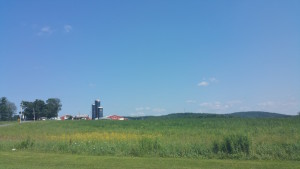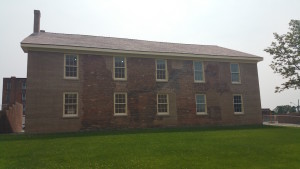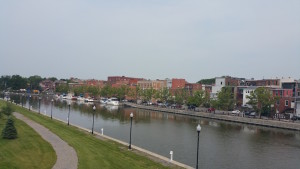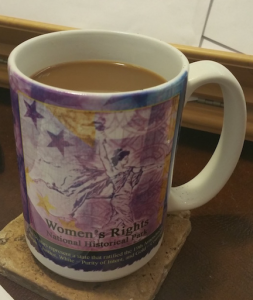Last summer I spent a week or so in upstate New York. In this post from August, I wrote about the drive out to Ithaca. In today’s post, let me take you on a few more adventures. Eventually I will get around to the journey home.
Though I drove to New York to spend time at Cornell, I didn’t stay in Ithaca. Too pricey (and, for the days I was there, all booked up). Instead, I stayed in Cortland, a town about half way between Ithaca and Syracuse. The daily drive to Cornell and back took me zig-zagging through a welter of state routes and highways that criss-cross at odd angles through the heart of Cortland — past an old church with its outer walls covered in river rocks arranged in geometric patterns; past an extraordinary, imposing red-brick Gilded-Age testament to the prestige of the press, the headquarters of the (still independently-owned, still-in-print!) Cortland Standard; past the small park in which a bronze Union soldier has stood sentry from his pedestal since “A.D. 1876.”
The sculpture, I have learned, was the work of Carl Conrads, a German immigrant who was himself a veteran of the Civil War. One of Conrads’s best-known works is “The American Volunteer,” and it seems that the people of Cortland County adopted that title for the memorial they commissioned and installed at a cost of “over $5,000.” I never stopped to look at the monument up close, but I marked it each day as I passed, and I thought of how many other towns in New York and Pennsylvania, Massachusetts and Ohio, Maine and Illinois, Connecticut, Rhode Island, and all across the north and east must have similar monuments of their own — on courthouse grounds, on main thoroughfares, in city parks, in public squares.
One day — it was a Sunday — I drove from Cortland to Seneca Falls. But I like to take the back streets, so instead of selecting “fastest route” in my car’s navigation system (affectionately known as “SkyNet Lite”), I selected “shortest distance.”
Well.
That route included a few miles’ worth of gravel roads, past weathered barns and whitewashed farmhouses and emerald pastures dotted with contented cows. Absolutely worth the rough going. I came around one bend in the road and spotted a critter I had never seen before — a big fat russet rodent of a thing, like a beaver with no tail, moving faster than a creature of such corpulence should move, its pelt shining like satin in the sun as it scurried across the road in front of my car. A groundhog! I counted seven on that drive — a lucky seven who all made the crossing without mishap.
In Seneca Falls, I visited the Women’s Rights National Historical Park. I arrived in time for a docent-guided talk on the history of the first Women’s Rights Convention in Seneca Falls in 1848. We were able to go inside the Wesleyan Chapel — much of brickwork on the outer walls had to be restored or replaced, and all the plasterwork on the inside walls is gone (except for a narrow strip or two protected by a plexi-glass cover. But (if I recall correctly) most of the bare timbers of the ceiling were original to the building. Somewhere in that weathered wood abides the echo of those vanished voices who spoke for equality — Lucretia Mott, Elizabeth Cady Stanton, Mary Ann M’Clintock, Frederick Douglass.

A sculpture in the Visitor Center of the Women’s Rights National Historical Park
I think that’s the idea — or one of them, anyhow — behind preserving historic sites: by a sort of transitive property, they bring us (we tend to believe, or feel, or hope) into something like physical contact with human lives long gone. We are in the same place, we feel. We stand where they stood, in the same spot, the same space, with only the thin veil of fleeting time between us. We walk the battlefields whose guns have stood silent for a century or two, and we can imagine that we are somehow walking alongside those long-departed volunteers.
But perhaps I am too cavalier with this word “we” — perhaps good, conscientious intellectual historians, such as I try to be, do not allow ourselves to think about the past in such simple, sentimental terms. This sense of the past, this way of knowing of which I speak — this is memory, not history. We are supposed to be above this, or beyond it, or somehow apart from it in our work. And I mostly am, or try to be.
As I understand it, the practice of history is a discipline that aims to render the past visible and comprehensible both from the inside (to recover past actors’ own sense of their time, their own understanding of the world in which they lived) and from the outside (constructing a larger picture of the past moment that no one living within it would have been able to draw, because no one who is inside of a time can ever see the whole of it). Of course, the accounts we fashion to report our findings are probably (necessarily?) less “true pictures” of past ways of thinking than inevitable reflections of our own present mindset and moment.
Maybe “less” is not the right word here. Maybe it is best to think of our work as not “less than” a true picture of past ways of thinking, but more than that — as true a picture of the past as we can offer, plus a bonus picture of the present too. For whatever historians do for our fellow humans in the present (not much, our fellow humans often seem to believe), what we leave behind for humans to come is just an ideational artifact of our own time — just what we think now about “back then,” so that our work will some day become part of a “back then” to their “now.”
And my “now” as a historian includes a “back then” that I can’t simply leave behind. I came to the practice of history through the halls of memory. It was not a penchant for ironic detachment and intellectual abstraction that led me to the scholarly study of the past. Those are skills (or, on some days, flaws) that I’ve had to learn. What led me to the study of the past was love — love for my grandparents, mostly : a wish to know everything there was to know about what made them who they were, and who they were to me, and a wish to keep as much of that with me, as much of them with me, as I can. I have since ventured far beyond that initial reason that history mattered to me. But that is the door through which I entered.
I suspect that a lot of people who come to the study of history (though not all, certainly) have come down such hallways and entered through such doors — through an interest in a relative’s war experiences, or their immigration story, or the history of one’s home town, or maybe just genealogical research. These are all very personal reasons for looking for the past — reasons that are not about holding the past at arm’s length, but about putting one’s arms around it.
Perhaps the Women’s Rights National Historic Park has been such a doorway for someone. Its establishment, its continued existence, certainly testifies to an idea that holds currency in the present: the idea that sites at which historically significant events took place should be both preserved and interpreted, so that visiting there can lead people to a better understanding of then. Perhaps that’s one way of describing the mission of public history: beginning with a there (or a that) to understand a then.
To an intellectual historian of the idealist strain, this can look a bit backwards. We tend to think of beginning with a then
(the sensibility of an era) in order to understand that there
— what that sensibility led to or accomplished or produced or left behind. That’s our epistemic home ground. Some of us just took the back streets to get here — pretty much the opposite of a shortcut, but (at least in retrospect) a sure path all the same.





0